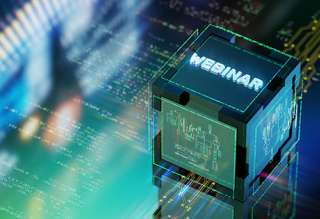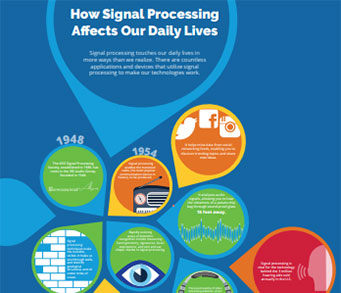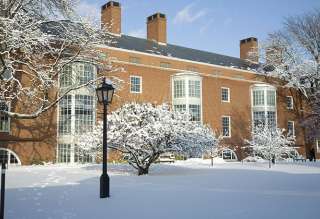SPS Feed
Top Reasons to Join SPS Today!
1. IEEE Signal Processing Magazine
2. Signal Processing Digital Library*
3. Inside Signal Processing Newsletter
4. SPS Resource Center
5. Career advancement & recognition
6. Discounts on conferences and publications
7. Professional networking
8. Communities for students, young professionals, and women
9. Volunteer opportunities
10. Coming soon! PDH/CEU credits
Click here to learn more.
The Latest News, Articles, and Events in Signal Processing
In this paper, we investigate the resource allocation problem for a full-duplex (FD) massive multiple-input-multiple-output (mMIMO) multi-carrier (MC) decode and forward (DF) relay system which serves multiple MC single-antenna half-duplex (HD) nodes. In addition to the prior studies focusing on maximizing the sum-rate and energy efficiency, we focus on minimizing the overall delivery time for a given set of communication tasks to the user terminals.
The problem of graph learning concerns the construction of an explicit topological structure revealing the relationship between nodes representing data entities, which plays an increasingly important role in the success of many graph-based representations and algorithms in the field of machine learning and graph signal processing.
JPEG lossy image compression is a still image compression algorithm model that is currently widely used in major network media. However, it is unsatisfactory in the quality of compressed images at low bit rates. The objective of this paper is to improve the quality of compressed images and suppress blocking artifacts by improving the JPEG image compression model at low bit rates.
We have recently seen great progress in image classification due to the success of deep convolutional neural networks and the availability of large-scale datasets. Most of the existing work focuses on single-label image classification. However, there are usually multiple tags associated with an image. The existing works on multi-label classification are mainly based on lab curated labels.
The mnemonic descent method (MDM) algorithm is the first end-to-end recurrent convolutional system for high-accuracy face alignment. However, the heavy computational complexity and high memory access demands make it difficult to satisfy the requirements of real-time applications. To address this problem, an improved MDM (I-MDM) algorithm is proposed for efficient hardware implementation based on several hardware-oriented optimizations.
Radial distortion has widely existed in the images captured by popular wide-angle cameras and fisheye cameras. Despite the long history of distortion rectification, accurately estimating the distortion parameters from a single distorted image is still challenging. The main reason is that these parameters are implicit to image features, influencing the networks to learn the distortion information fully.
The performance of ellipse fitting may significantly degrade in the presence of outliers, which can be caused by occlusion of the object, mirror reflection or other objects in the process of edge detection. In this paper, we propose an ellipse fitting method that is robust against the outliers, and thus maintaining stable performance when outliers can be present.
Gait recognition aims to recognize persons' identities by walking styles. Gait recognition has unique advantages due to its characteristics of non-contact and long-distance compared with face and fingerprint recognition. Cross-view gait recognition is a challenge task because view variance may produce large impact on gait silhouettes.
Monitoring all the internal flows in a datacenter is important to protect a victim against internal distributed denial-of-service (DDoS) attacks. Unused virtual machines (VMs) in a datacenter are used as monitors and flows are copied to the monitors from software defined networking (SDN) switches by adding some special rules. In such a system, a VM runs a machine learning method to detect DDoS behavior but it can only process a limited number/amount of flows.
User activities in cyberspace leave unique traces for user identification (UI). Individual users can be identified by their frequent activity items through statistical feature matching. However, such approaches face the data sparsity problem. In this paper, we propose to address this problem by multi-item-set fingerprinting that identifies users not only based on their frequent individual activity items, but also their frequent consecutive item sequences with different lengths.
Identifying information sources plays a significant role in network science and engineering. However, existing source identification approaches generally focus on static networks without considering the temporal features of networks. To this end, we comprehensively study the problem of identifying single and multiple information sources in time-varying networks.
We present an all-in-one camera model that encompasses the architectures of most existing compressive-sensing light-field cameras, equipped with a single lens and multiple amplitude coded masks that can be placed at different positions between the lens and the sensor. The proposed model, named the equivalent multi-mask camera (EMMC) model, enables the comparison between different camera designs, e.g using monochrome or CFA-based sensors, single or multiple acquisitions, or varying pixel sizes, via a simple adaptation of the sampling operator.
Recently, deep learning-based compressive imaging (DCI) has surpassed conventional compressive imaging in reconstruction quality and running speed. While multi-scale sampling has shown superior performance over single-scale, research in DCI has been limited to single-scale sampling. Despite training with single-scale images, DCI tends to favor low-frequency components similar to conventional multi-scale sampling, especially at low subrates.
In this article, we propose a method to reconstruct the total electromagnetic field in an arbitrary two-dimensional scattering environment without any prior knowledge of the incident field or the permittivities of the scatterers. However, we assume that the region between the scatterers is homogeneous and that the approximate geometry describing the environment is known.
Most digital cameras use specialized autofocus sensors, such as phase detection, lidar or ultrasound, to directly measure focus state. However, such sensors increase cost and complexity without directly optimizing final image quality. This paper proposes a new pipeline for image-based autofocus and shows that neural image analysis finds focus 5-10x faster than traditional contrast enhancement.
Submission Deadline: May 20, 2021
Call for Proposals Document
The upcoming 5G network needs to achieve substantially larger link capacity and ultra-low latency to support emerging mobile applications. While conventional techniques have reached their limits, uplifting the carrier frequency to the millimeter-wave (mm-wave) band stands out as an effective approach to further boost the network capacity, as it provides orders of magnitude greater spectrum than current cellular bands.
Most of the existing feature representations for spoofing countermeasures consider information either from the magnitude or phase spectrum. We hypothesize that both magnitude and phase spectra can be beneficial for spoofing detection (SD) when collectively used to capture the signal artifacts. In this work, we propose a novel feature referred to as modified magnitude-phase spectrum (MMPS) to capture both magnitude and phase information from the speech signal.
Voice and face are two most popular biometrics for person verification, usually used in speaker verification and face verification tasks. It has already been observed that simply combining the information from these two modalities can lead to a more powerful and robust person verification system.
Pages
SPS Social Media
- IEEE SPS Facebook Page https://www.facebook.com/ieeeSPS
- IEEE SPS X Page https://x.com/IEEEsps
- IEEE SPS Instagram Page https://www.instagram.com/ieeesps/?hl=en
- IEEE SPS LinkedIn Page https://www.linkedin.com/company/ieeesps/
- IEEE SPS YouTube Channel https://www.youtube.com/ieeeSPS









